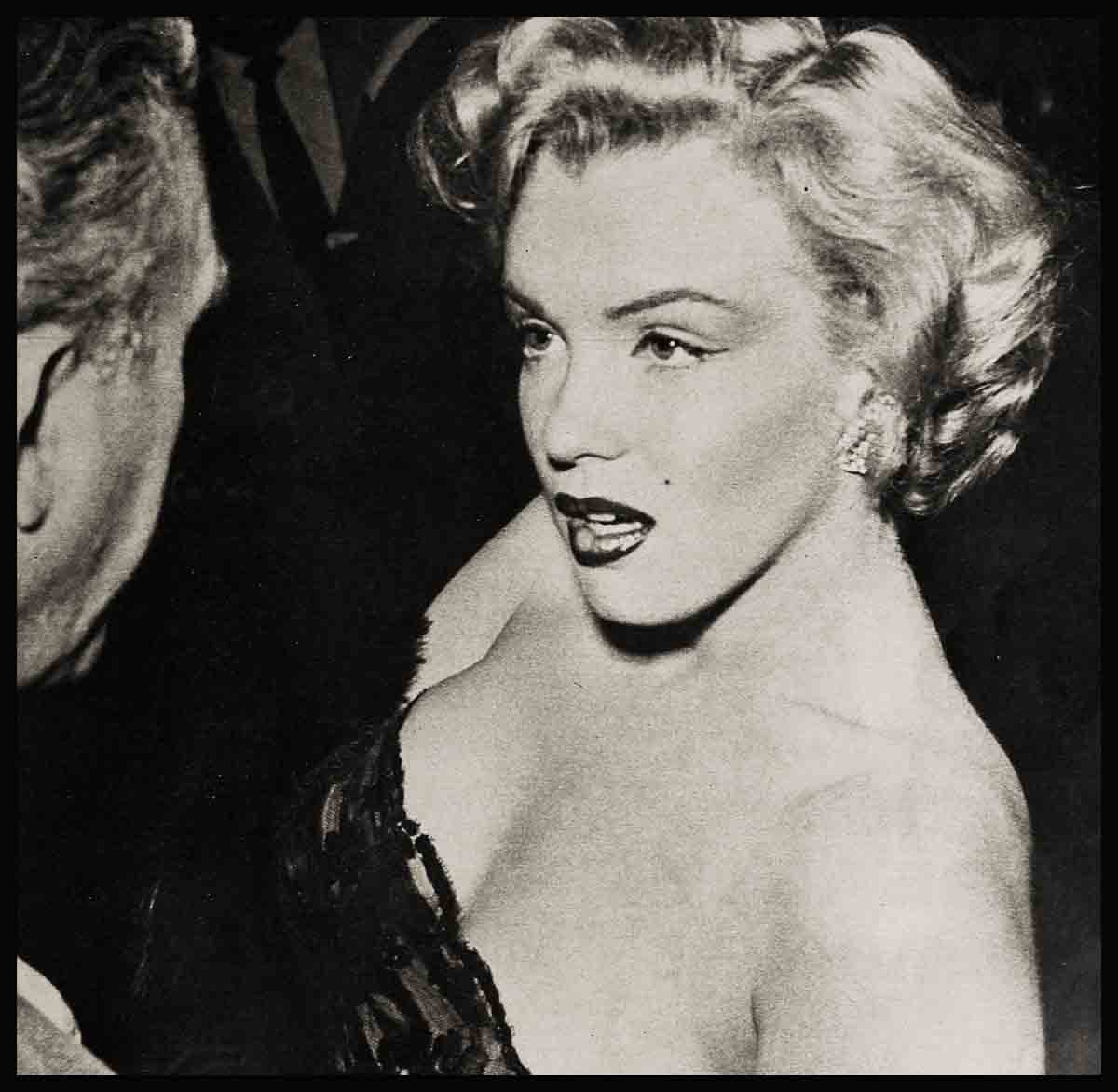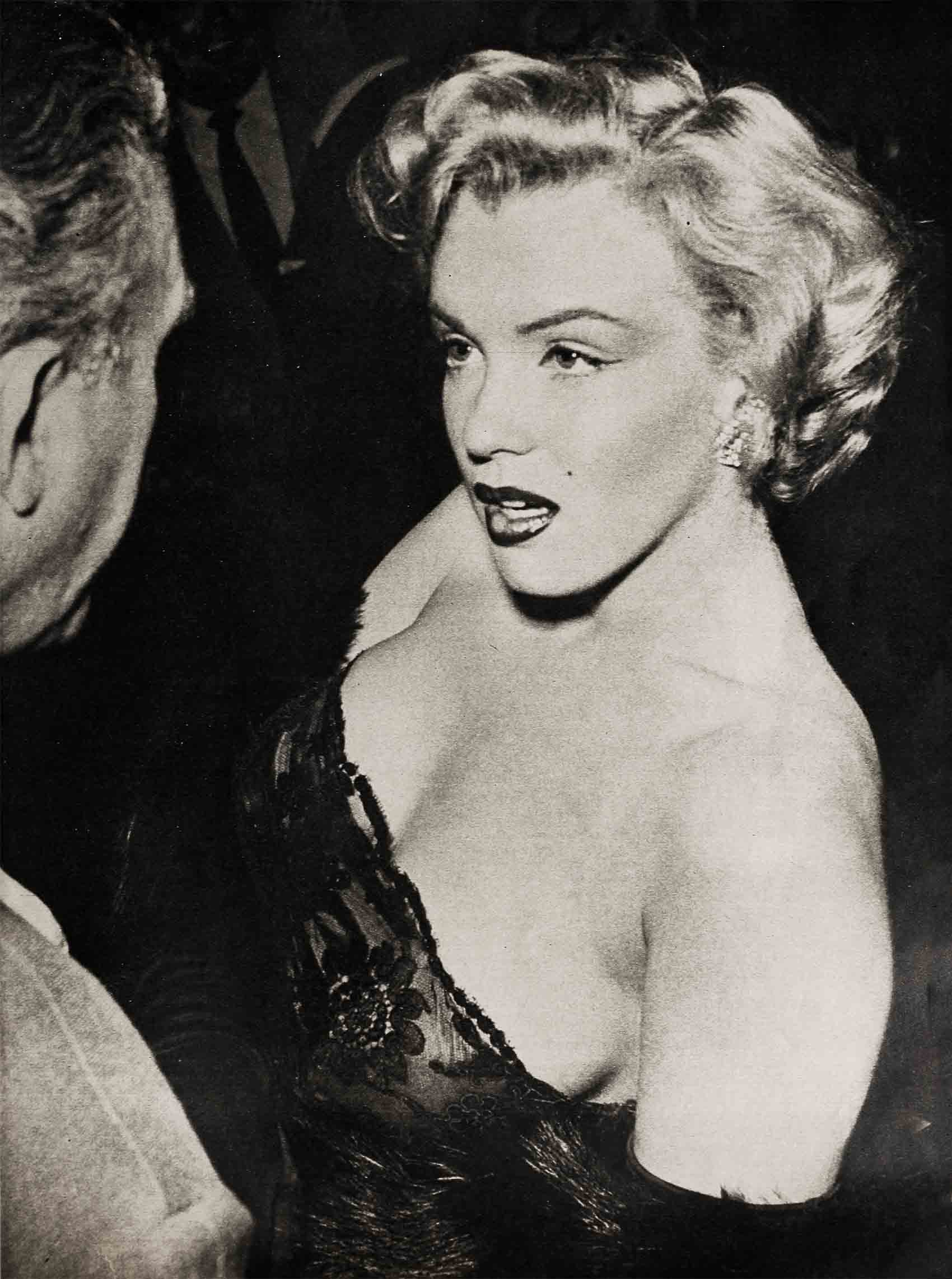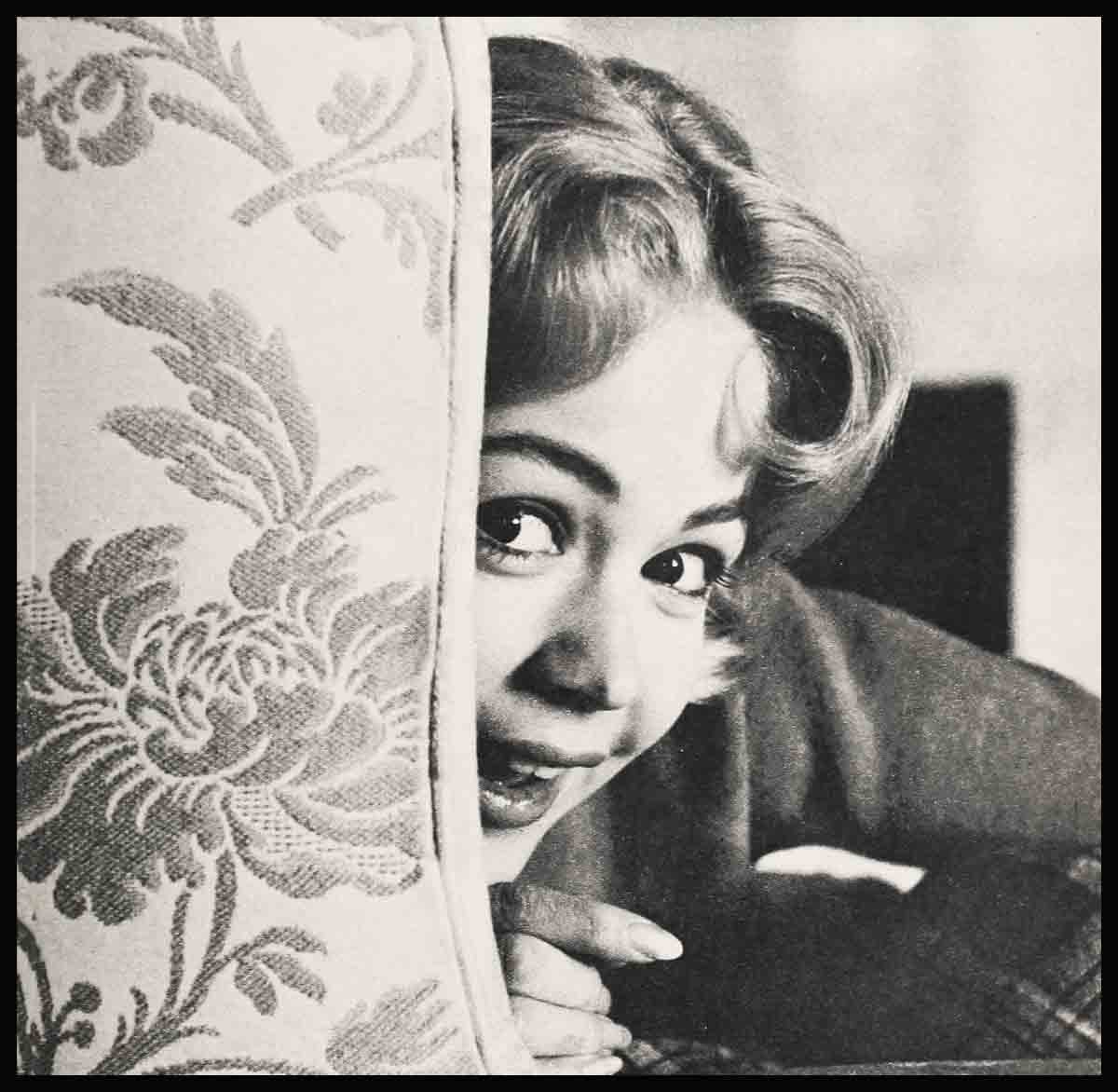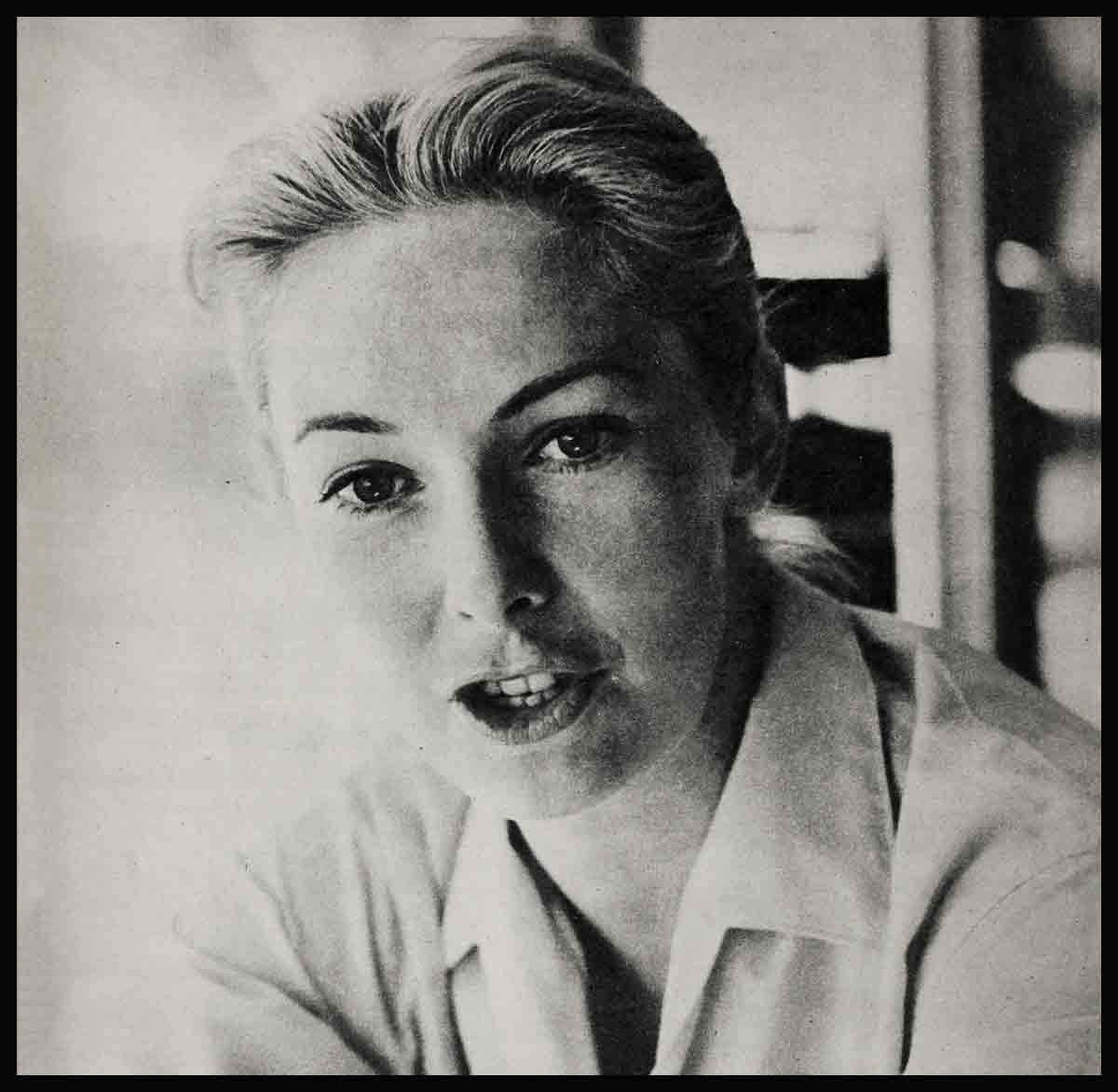
Am I For Daring?—Marilyn Monroe
Am I too daring?
I ask this question in all sincerity because, in recent months, a number of influential women have told me that perhaps I am. I have been accused of having horrible taste in clothes, told that I am flaunting the gentler traditions of womanhood, and that I have made a common display of my figure on every social occasion.
In my own heart, I cannot believe that these accusations are true, and when they first began to appear in several of the Hollywood columns, they hurt me deeply. I felt that perhaps I had unintentionally offended someone. Then I ran through every possible—reason why I should be attacked on these grounds, and I worried.
Quite understandably, when a girl is just starting her career in Hollywood, she can’t help but worry when she wakes up one morning and reads that perhaps she is seriously jeopardizing her motion picture career by the way she dresses. That’s potent criticism, and it pays to consider it carefully.
In my case, I had a special reason to worry—one which, at the time, made it impossible for me to answer back. Frankly, I was concerned about how Hollywood was going to accept the news that only a few weeks before, on January first, 1952, to be exact, a nude calendar for which I posed in 1949 had turned up on garage and barber shop walls all over America. Only a few people knew it was me, but I realized it would be just a matter of time until someone on the newspapers tracked down the story.
I have never been ashamed that calendar job, which I did as a legitimate figure model at a time in my life when the $50 I was paid looked like the vaults at Fort Knox. It was the first, last and only job of figure modeling I ever did in Hollywood. But having the news break at a time when several women were already making a point about my flamboyant taste in clothes, I quite naturally felt that both the calendar and the reasons why I posed for it might be misinterpreted.
I was advised to deny that it was me. But how can you deny anything so obvious? There must have been several hundred thousands of the calendar printed; you can get one anywhere. Anyone can tell that it is me, even though my hair was longer then and partially covered my face. So why try to deny it?
At the time I posed for the pictures, I was living in the Hollywood Studio Club, trying to pay for dramatic lessons with the irregular income I made as-a model. Other than a few random fashion jobs, which pay very little on the West Coast, I hadn’t worked for nearly a month; I was flat broke, the finance company was after my ear, and I was four weeks behind in my rent. One day, in desperation, I called Tom Kelley, who is one of Hollywood’s most artistic photographers, and told him I was willing to pose for the calendar job he had been asking me to do, off and on, for several weeks. As I told reporters, the job was perfectly professional and proper. Tom, who was shooting a series for an eastern calendar company, wanted a blonde model to illustrate the title “Golden Dreams.” We worked only 30 minutes and he shot me in two poses. His wife was there, helping with the drapes and the lights. And the $50 he paid me for the job, I might add, was the most important money I’ve ever earned. It helped me to keep going until I got my first really important break in movies a few months later, in The Asphalt Jungle.

I am retelling this story, which has appeared everywhere by now, not. because I like the story especially, but because I do not want it to have any relation to what I intend to say about the way I dress. I don’t think it would be fair, and I do not want to put myself in a position where the obvious facts of my life can be distorted. I am very grateful that Hollywood has understood the circumstances associated with my posing for that calendar. It makes me wonder, in fact, just how much attention I should pay today to the criticism of my taste and habits of dress. Not much, I’ve come to think.
You see, I’m forced to admit that all of my adult life I have preferred to dress for men rather than for other women. For this reason, I suppose, I can not expect other women to appreciate or even like my clothes. But I do, and I was hurt by the accusation that I have no taste in my manner of dress. It is simply that, during the relatively few years I have been able to afford pretty clothes, I have always been most at ease when I am presenting myself on an unmistakably feminine level. Every suit, every dress, and every gown I own was carefully selected for its potential effect. Personally, too, I feel that if more women followed this same principle they would be more feminine. But that’s only my own opinion.
I have always been clothes-conscious. Back in junior high school, I was painfully so when my entire wardrobe consisted of two hand-me-down navy wool skirts, two identical white cotton blouses, and an old red corduroy jacket. Then my only thought was that someday I might own, not a big wardrobe, but just enough clothes so other girls wouldn’t make fun of me.
A few years later, at the age of 16 I began modeling, and was able to buy my first good dresses—dresses that fit. I discovered Vogue and Harper’s Bazaar and, at the same time, discovered that the clothes they featured were designed for, and modeled by, women with boys’ figures. Even at that age, I realized that I didn’t have a boy’s figure. I certainly don’t now.
I wonder how many women really fall for that routine under the pictures of sliver-hipped models in the fashion magazines— “You can be an entrancing, new, exciting you, madam.” Obviously, they must discover that they can’t be the minute they go to a store and try on one of those creations, that is, if they can get it on in the first place.
Personally, I never tried to. When I was still a girl, I realized that I had a full woman’s figure. I know, too, that my figure enabled me to earn a living as a model for several years before I got into movies. What, I ask you, is wrong with that?
Even today, I do not own an extensive wardrobe; I can’t yet afford one. In fact, the clothes I own have had such a personal meaning in my life that I can remember every outfit I have ever bought since I started-in pictures. They are all good clothes, however, and I think they are in quite good taste, if seemingly somewhat flamboyant.

The first expensive clothes I ever owned were the three suits which I bought on credit from a Hollywood ladies’ shop when Twentieth first signed me in 1948. They were all expensive—one grey, one beige, and one dark blue dress suit. In a flush of enthusiasm, I also bought every accessory to go with them—also on credit. I learned a lesson from those clothes, and I never really wore them comfortably, for three months later, when Twentieth dropped my option, I couldn’t pay for them. The minute I stopped working the collection agencies descended en masse. I had an awful time getting that bill paid, and I swore never again to buy any of my clothes on credit.
Believe it or not, I did not own a single cocktail dress until a few weeks after I’d completed Asphalt Jungle.Then I bought a simply-styled, black silk faille dress with a long narrow slit down the front which is held together with a tie. I wore it with black arm-length gloves and no $125 was ever better spent, in my opinion. Some people thought it was a little daring, but I love the dress, now as then. I wish I could still wear it to parties, but it has had its day, I’m afraid.
My first expensive evening gown was the one I purchased for the Foreign Press Association’s annual dinner, where I was presented with a Henrietta award, and named as one of Hollywood’s most promising young players. I very gratefully accepted the award, and later, was told I looked nice doing it. But I also heard that some of ‘the women present had thought my gown a trifle extreme for the occasion. I seriously considered these comments, but, in my opinion, they were not reason enough to take the gown back to Oleg Cassini, who designed it. I’ve always admired his taste and imagination in women’s clothes, and my gown is no exception. It is a red velvet creation which fits snugly down to the knees and then flares out, in the Lillian Russell tradition. It plunges somewhat in the front, but not extremely. Frankly, I love the gown and wish I had more occasions to wear it.
I have another evening gown which other women criticize but which has won me an appreciable number of fine compliments from men. It is a strapless red silk taffeta, snug from the bodice down to the hips, which is covered with black French lace. At I. Magnin’s, where I paid a stiff price for it, I was told that the dress was the only copy of an original purchased by a San Francisco social leader. I wonder if her dress has ever . been criticized in her set the way mine was the night I wore it to one of the few formal Hollywood parties I have attended. This is the gown that provoked so much comment from the Hollywood columnists . . . it was the proof positive, they claimed, that I was utterly lacking in taste. I’m truly sorry, but I love the dress.
My favorite dress, however, is an off-the-shoulder cocktail dress, made of beige lace over coffee-colored silk. It has a sort of tail effect in the back.
My only other new cocktail dress is a black silk by Ceil Chapman which has a big puff at the side and drapes tightly around my legs. I like its slimming effect.
I have also heard a number of comments about the two suits which I own, both of which are simply styled and, I think, tastefully designed. Perhaps it is the way I wear them; I honestly don’t know. The black one, by Christian Dior, I wear with a simple red beret, black pumps, and a red rose at the bosom to add a touch of color. The beige one, I wear with brown shoes and a yellow rose. I rarely wear costume jewelry, but I like flowers. I don’t think however, that either suit is made especially provocative by wearing flowers with it.
The other day, when I was hurrying to the makeup department across the lot, wearing blue jeans and a T-shirt I had put on hurriedly at home, I was stopped by one of the executives in the casting department who told me, “Marilyn, you shouldn’t wear blue jeans on the lot.” “Why?” I asked, thinking that of all places, the lot was the one place I could feel completely at home. “An actress should always look her best,” he said.
I suppose this is true. But I have always felt comfortable in blue jeans—they’re my favorite informal attire. I have found it interesting, however, that people whistle at jeans, too. I have to admit that I like mine to fit. There’s nothing I hate worse than baggy blue jeans.
I have only a few other idiosyncrasies about clothes. I like bare-looking shoes for both formal and informal occasions. I believe, like the classic Greeks, that a woman’s feet are an important part of her beauty. Furthermore, when I dress for formal occasions, I never wear a girdle or other confining garments. Freedom of movement is very important to a woman, psychologically as well as physically.
During the brief period I have been in motion pictures, I have always considered that my clothes and the way I wear them are very important to me. But I have never consciously tried to make a public display of my clothes.
I suppose, however, because of my background as a model, I will always have to expect that a tinge of daring might seem to be associated with my attire. Not very long ago, I wore the bathing suit which I model in We’re Not Married to lunch in the commissary at Twentieth. With a robe over it, of course. The next morning, I was surprised to read in a column that I was seen eating lunch in my bra and panties. I suppose that from across the room the flesh-colored inset on my suit made me seem scantily attired. But I wasn’t.
I know myself rather well, I think. Personally, I don’t consider myself too daring, in my dress or in my behavior.
I leave it to you to decide. Am I too daring?
THE END
—BY MARILYN MONROE
It is a quote. MODERN SCREEN MAGAZINE JULY 1952





No Comments